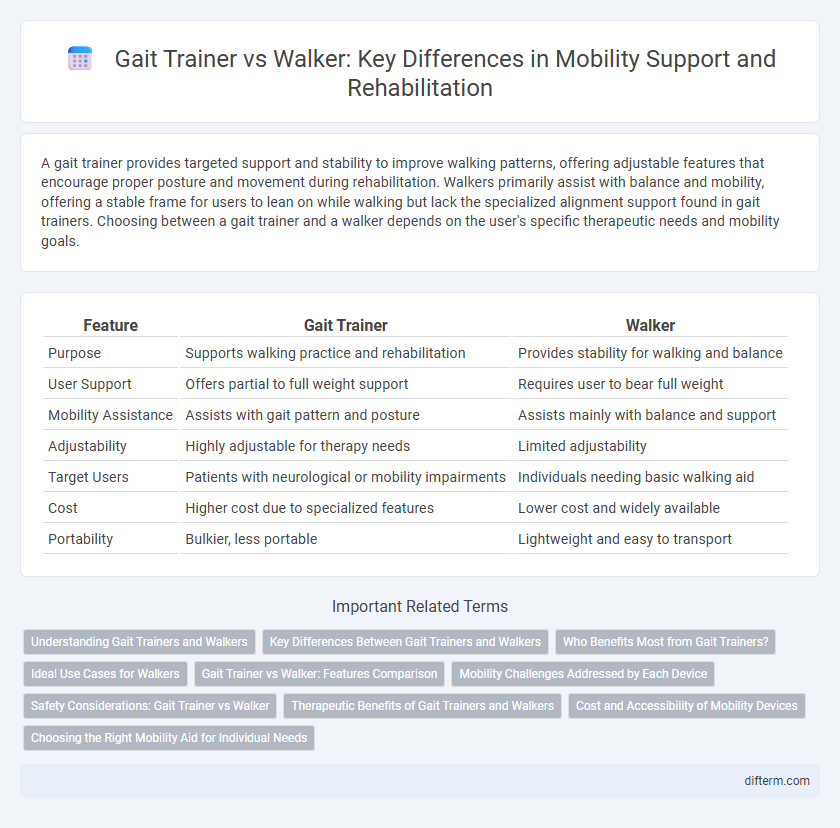A gait trainer provides targeted support and stability to improve walking patterns, offering adjustable features that encourage proper posture and movement during rehabilitation. Walkers primarily assist with balance and mobility, offering a stable frame for users to lean on while walking but lack the specialized alignment support found in gait trainers. Choosing between a gait trainer and a walker depends on the user's specific therapeutic needs and mobility goals.
Table of Comparison
| Feature | Gait Trainer | Walker |
|---|---|---|
| Purpose | Supports walking practice and rehabilitation | Provides stability for walking and balance |
| User Support | Offers partial to full weight support | Requires user to bear full weight |
| Mobility Assistance | Assists with gait pattern and posture | Assists mainly with balance and support |
| Adjustability | Highly adjustable for therapy needs | Limited adjustability |
| Target Users | Patients with neurological or mobility impairments | Individuals needing basic walking aid |
| Cost | Higher cost due to specialized features | Lower cost and widely available |
| Portability | Bulkier, less portable | Lightweight and easy to transport |
Understanding Gait Trainers and Walkers
Gait trainers provide intensive support and alignment for individuals relearning to walk, offering adjustable harnesses and wheels designed to enhance balance and posture during ambulation. Walkers deliver basic stability and support primarily for users with mild mobility limitations, featuring a lightweight frame that facilitates upright walking. Selecting the appropriate device depends on the user's specific mobility goals, level of independence, and rehabilitation needs.
Key Differences Between Gait Trainers and Walkers
Gait trainers offer dynamic support and promote natural walking patterns by providing adjustable trunk and pelvic stabilization, making them ideal for individuals needing extensive motor control assistance. Walkers primarily provide static support with handles and four points of contact to enhance balance and mobility for users with mild to moderate stability issues. The key difference lies in the level of support and functionality, with gait trainers facilitating active gait therapy while walkers serve as simple mobility aids.
Who Benefits Most from Gait Trainers?
Gait trainers primarily benefit individuals with limited or no independent walking ability, such as those with cerebral palsy, spinal cord injuries, or stroke survivors undergoing rehabilitation. They provide dynamic support and facilitate repetitive walking practice to improve motor coordination, balance, and strength. Unlike walkers, which are suited for users with some walking stability, gait trainers are essential for patients needing intensive gait training and postural control assistance.
Ideal Use Cases for Walkers
Walkers are ideal for individuals who require minimal assistance with balance and stability during walking, such as those recovering from minor injuries or managing mild mobility impairments. They provide a sturdy, lightweight frame for support and are best suited for users who can bear weight on both legs and have adequate upper body strength. Unlike gait trainers, walkers do not offer guided movement patterns, making them more appropriate for those needing straightforward support rather than intensive gait retraining.
Gait Trainer vs Walker: Features Comparison
Gait trainers offer enhanced postural support and adjustable settings to promote proper walking patterns, making them ideal for rehabilitation and therapeutic use. Walkers typically provide basic stability and balance assistance without the dynamic support features found in gait trainers. The choice between a gait trainer and a walker depends on the user's mobility level, therapeutic needs, and goal to improve functional gait versus general ambulatory support.
Mobility Challenges Addressed by Each Device
Gait trainers primarily address severe mobility challenges by providing enhanced support and stability for individuals with significant gait impairments, promoting proper posture and repetitive walking practice. Walkers are designed for individuals with moderate mobility limitations, offering balance assistance and weight support to facilitate independent ambulation. Both devices improve mobility outcomes but target different levels of functional ability and rehabilitation needs.
Safety Considerations: Gait Trainer vs Walker
Gait trainers offer enhanced stability and support with built-in harness systems that reduce fall risks, making them suitable for users with significant balance impairments. Walkers provide basic support but lack comprehensive fall protection features, which can increase the likelihood of accidents for individuals with severe mobility challenges. Selecting the appropriate device depends on the user's balance capabilities and safety requirements to minimize injury risks during ambulation.
Therapeutic Benefits of Gait Trainers and Walkers
Gait trainers provide targeted therapeutic benefits by promoting proper walking patterns, improving balance, and enhancing muscle strength through guided support tailored to individual mobility needs. Walkers offer stability and independence for users with mild to moderate mobility challenges, aiding in weight distribution and reducing fall risk during ambulation. Both devices play crucial roles in rehabilitation, with gait trainers emphasizing motor learning and walkers prioritizing functional mobility maintenance.
Cost and Accessibility of Mobility Devices
Gait trainers typically have a higher cost compared to standard walkers due to their advanced features and customization options, which can impact accessibility for some users. Walkers are generally more affordable and widely available, making them a practical choice for users with budget constraints or limited access to specialized equipment. Insurance coverage and regional availability also influence the accessibility of each device, with walkers often benefiting from broader support in healthcare programs.
Choosing the Right Mobility Aid for Individual Needs
Selecting the appropriate mobility aid requires assessing individual gait stability, strength, and rehabilitation goals; gait trainers offer enhanced support for those needing guided walking assistance and posture correction, while walkers provide greater independence for users with sufficient balance and strength. Customizing aid choice based on functional mobility levels and therapeutic objectives ensures optimal safety and mobility outcomes. Consulting with healthcare professionals enables tailored solutions that adapt to evolving needs and promote long-term mobility success.
gait trainer vs walker Infographic

 difterm.com
difterm.com